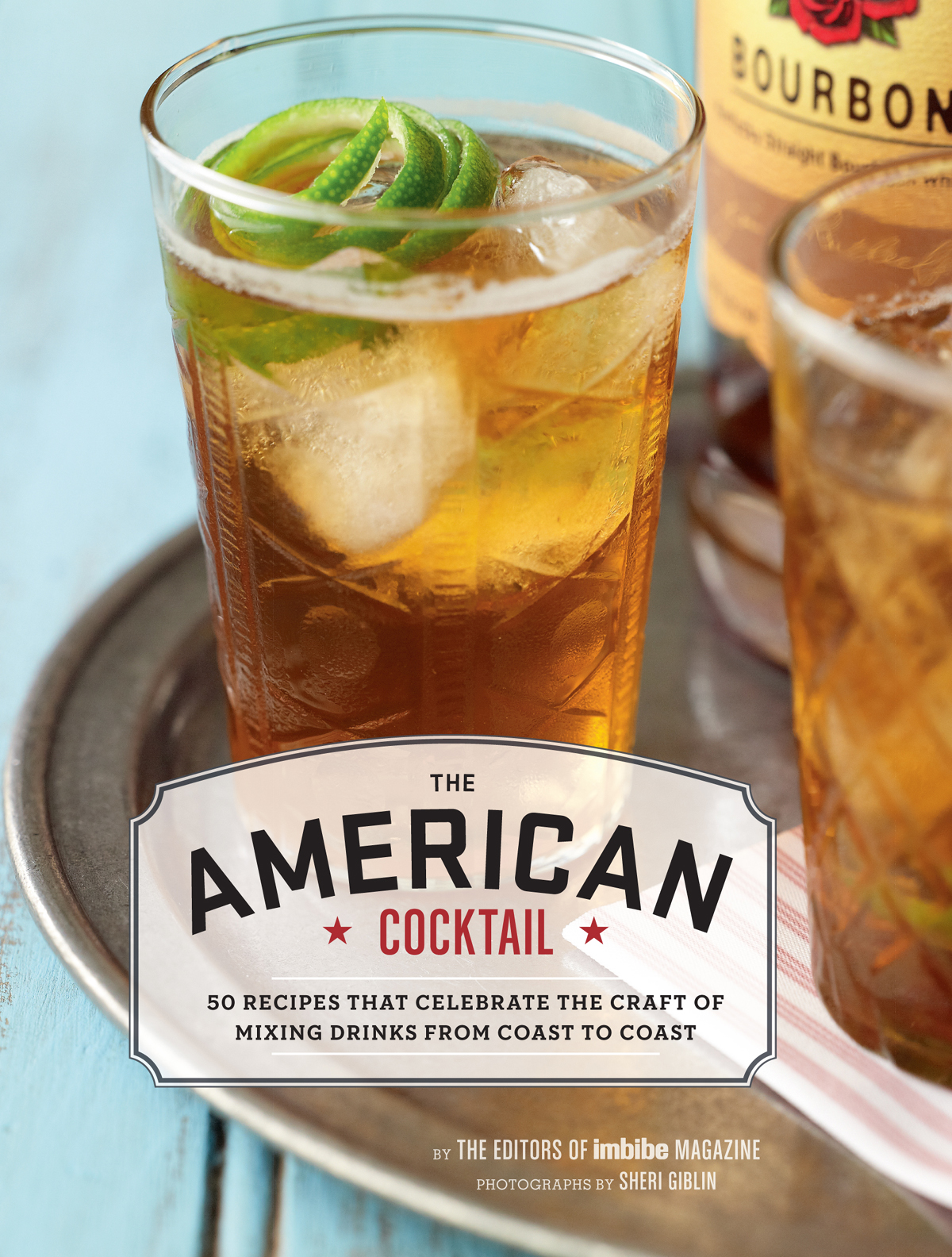

AMERICA HAS A STORIED PAST WITH SPIRITS AND COCKTAILS. As immigrants from around the world settled in cities and towns across the country, they brought the culinary traditions that inform the way we drink today. Thanks to the industrious, whiskey-loving settlers of the South, we have Kentucky bourbon country, and if it hadnt been for nostalgic Italian immigrants, Californias Bay Area might not have experienced its love affair with Italian amari.
While these influences remain as steadfast as ever, Americas melting pot of culinary traditions has also spawned new trends across the country, from the fresh, seasonal cocktails of the West Coast to the classically inspired drinks of the South. Whats more, uniquely American ingredients have found their way into some of the countrys best cocktails, from bacon- infused bourbon blended with Carolina-made ginger ale to a loquat-and-lemon cocktail mixed with artisanal vodka made in Texass oldest legal distillery.
Now you can experience these drinks for yourself. The fifty cocktail recipes presented here were gathered from talented bartenders across the country and feature regionally produced spirits, sodas, fruits, herbs, and even tea. Whether youre imbibing a Persimmon Margarita in Los Angeles or a Mint Julep in Louisville, the cocktails that define the American landscape are deliciously diverse. Consider this book your personal cross-country tour of Americas most intriguing regional cocktail flavors, traditions, and stories.
Travel should always be this satisfying.

COCKTAIL BASICS

In order to make great cocktails, you need to have a basic understanding of the tools and techniques required for home mixology. You dont need to purchase the most expensive tools, and you can find most of what we outline in this section very affordably either online or in your local grocery store or housewares shop. Imbibe has reviewed most of these tools in previous issues and/or on our Web site, so you can also consult the magazine for recommendations (www.imbibemagazine.com).
Gearing up to mix cocktails requires a simple setup that you can add to over time as you get more serious about drink making. To begin, be sure you have a measuring glass, shaker, barspoon, muddler, Hawthorn strainer, fine-mesh strainer (which you probably already have in your kitchen), and some toothpicks. Over time, you can add items like a Boston shaker, a channel knife, specialty ice trays, an ice crusher, decorative cocktail picks, and other useful gadgets.
Barspoon: Usually about 12 inches long (but sometimes longer) with a swiveled shaft, barspoons are essential for stirring cocktails. You can also use them for measuring ingredients; 1 barspoon equals approximately 1 teaspoon.
Boston shaker: A two-piece cocktail shaker consisting of a glass mixing vessel designed to fit securely inside the top metal tumbler. The Boston shaker does not have a built-in strainer.
Channel knife: A small handheld tool designed to cut a fruits rind when drawn over its surface, and perfect for creating citrus peels and twists.
Fine-mesh strainer: A small, handheld strainer with very tight mesh designed to keep particulates out of a finished drink. Often used for double straining cocktails. Also known as a tea strainer.
Hawthorn strainer: A stainless-steel strainer with a wire coil, which is designed to fit snugly over a mixing glass, enabling you to strain a cocktail into a glass. Often used in cojunction with a fine-mesh strainer for double straining cocktails.
Ice crusher: Available in both electric and hand-crank versions, these handy little machines are useful if you frequently need larger quantities of crushed ice.
Jigger: A tool used to measure liquid for cocktails. A jigger holds 1 ounces.
Measuring glass: A small glass used for measuring out cocktail ingredients. Look for one with measurements in ounces.
Mixing glass: A pint glass or the bottom half of a Boston shakereither glass or metal (often referred to as a tin)used for muddling ingredients, stirring drinks, or combining ingredients for shaken cocktails.
Muddler: A pestle-like tool used to crush fruit and/or herbs in a glass to extract their flavors.
Strainer: Refers to either the built-in strainer of a cocktail shaker or a stand-alone Hawthorn strainer.
Three-piece cocktail shaker: A metal shaker with a tight-fitting lid and a built-in strainer. Also known as a cobbler shaker.
Whipped cream siphon: A canister that uses chargeable gas cartridges to create and dispense whipped cream.
Wondering what it means to dry shake? Not sure how to double strain a cocktail? Heres a nuts-and-bolts overview of some of the most common cocktail-making tricks and techniques.
Double straining: Straining a cocktail through both the strainer in the lid of the shaker (or Hawthorn strainer if using a Boston shaker) and a fine-mesh strainer held over the glass.
Dry shaking: Shaking a cocktail without ice.
Glass chilling: Chilling glasses that are used for cocktails served up (with no ice) to ensure a cocktail remains chilled once poured. You can do this by putting a glass in the freezer for a few minutes prior to using or by placing a few ice cubes in a glass and then discarding them before using the glass.
Glass warming: Rinsing a glass with hot water before using for a cocktail. Often used for hot cocktails to help the drink stay warm.
Layering: Separating a layer of cream or another liquid ingredient from the rest of the cocktail, such as in Irish Coffee. You can achieve this by slowly pouring the liquid over the back of a spoon on top of the drink.
Muddling: Using a muddler to press and/or break down ingredients, such as fruit and herbs, in the bottom of a shaker or glass.
Rimming a glass: Coating the edge of a glass with an ingredient of choice, most commonly sugar or salt, in such drinks as Margaritas and Sidecars.
Shaking: Using plenty of ice and shaking vigorously until the outside of the shaker is frostedno wimpy shaking allowed. Cocktails that combine syrups, juices, or other ingredients that need to be well-incorporated with spirits are typically shaken.
Stirring: Using a barspoon and stirring with plenty of ice until the mixing glass begins to frost. Spirits-driven cocktails, such as a Manhattan, are generally stirred so as not to agitate the spirits too much by shaking.
A garnish can be a cocktails pice de rsistance. Whether its a brandied cherry, a salted rim, or a playful citrus twist, garnishes often add just the right finishing touch to a cocktail, sometimes amplifying depth of flavor and/or aroma, and sometimes simply making a drink look more beautiful. There are many more types of garnishes not detailed here, but following are some of the ones most commonly used.
Cherry: Fresh cherries, brandied cherries, maraschino cherries, or Marasca cherries, such as those made by Luxardo and available at www.kegworks.com.
Citrus peel: A swath of citrus peel that is usually twisted over a drink to release the fruits essential oils and sometimes placed in the cocktail as a garnish. To make a peel, use a vegetable peeler or paring knife. If using a knife, simply cut a thin piece of the peel, being careful not to include any flesh. The pieces can range from a round quarter size to a 1-by-2-inch piece.
Next page
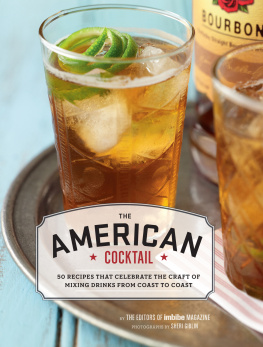
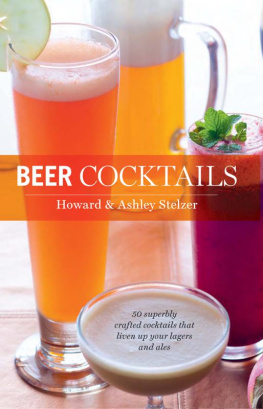

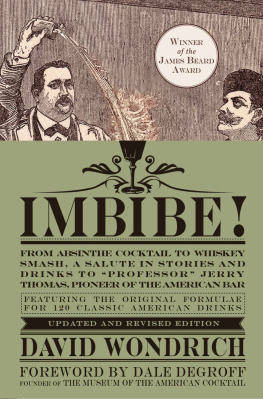

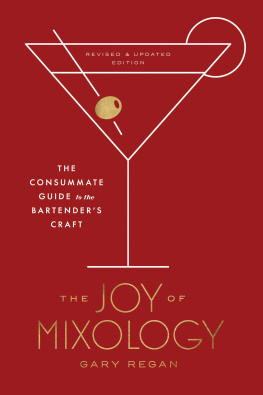


 COCKTAIL BASICS
COCKTAIL BASICS